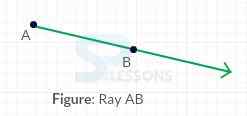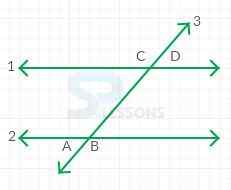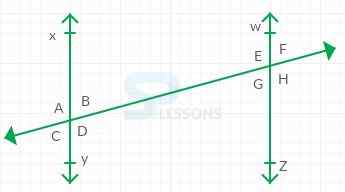 Introduction
Introduction
This chapter primarily focuses on the properties of lines, points, angles and polygons. Regardless of the greater part of the subject branches of mathematics of geometry that exist, maybe geometry has the most significant effect on our everyday lives. Consider the environment you are in right at this point.
Quantitative Aptitude -BANKING|SSC|RAILWAYS|INSURANCE|RECRUITMENT EXAMS - EBOOKS
 Methods
Methods
1. Points:
Regular polygon:
- In geometry, points help to determine exact locations.
- Points are generally represented by a number or letter.
- Since points determine a single, exact locations (but are not objects in themselves), they are zero-dimensional.
- In other words points have no length, width, or height.
- They just show up as items when drawn on a paper.
- A ray is a "straight" line that starts at one point and develops infinitely in one direction.
- A ray has one endpoint, which denote the position from where it starts.
- A ray starting at the point A that goes through point B is indicated as [latex]\overrightarrow{AB}[/latex].
- This representation demonstrates that the ray starts at point A and broadens infinitely toward point B.
- Lines in geometry might be considered as a "straight" line that can be drawn on paper with a pencil and ruler.
- Rather than this line being limited by the measurements of the paper, a line expands limitlessly in both directions.
- A line is one-dimensional, having length, however, no width or height.
- Lines are uniquely determined by two points.
- Therefore, the name of a line going through the points A and B is represented as [latex]\overleftrightarrow{AB}[/latex], where the two-headed arrow implies that the line goes through those unique points and extends endlessly in both directions.
- Lines and line segments differ because a line segment has a defined length, whereas a line does not.
- It is represented as [latex]\overline{AB}[/latex].
- The term intersect is used when lines, rays, line segments or figures meet, that is, they share a common point.
- The point they share is called the point of intersection.
- An end point is a point used to define a line segment or ray.
- A line segment has two endpointd whereas a ray has one end point.
- Two lines in the same plane which never intersect are known as parallel lines.
- Two line segments are parallel if the lines that they lie on a parallel.
- If [latex]L_{1}[/latex] is parallel to [latex]L_{2}[/latex], then it is represented as [latex]L_{1} \parallel L_{2}[/latex].
- An angle is framed when two rays meet at a typical endpoint, or vertex.
- The two sides of the angle are the rays, and the point that joins them is known as the vertex.
- An acute angle is an angle whose measure is less than 90°.
- For these sorts of points, a square couldn't fit splendidly at the convergence of the two lines that frame them.
- Obtuse angles have measures greater than 90° but less than 180°.
- Two angles are known as complementary if the sum of their degree measurements equals 90 degrees.
- One of the complimentary angles is said to be complement of the other.
- Two angles are known as supplementary if the sum of their degree measurements equals 180 degrees.
- One of the supplementary angles is said to be supplement of the other.
- When two lines intersect, the angles that lie opposite to each other called vertically opposite angles, are always equal.
- An angle bisector is a ray that divides an angle into two equal angles.
- Lines are perpendicular if their intersection forms a right angle and if one of the angles formed by the intersection of two lines or segments is a right angle, then all four angles created will also be right angles.
- This also shows that the degree measurement of four angles formed by two intersecting lines will add up to 360 degrees.
- A traversal creates eight angles when it intersects with two parallel lines.
- The eight angles created by these two intersections have special relationships to each other.
- For any pair of parallel lines 1 and , that are both intersected by a third line, such as line 3 in the figure shown.
- Angle A and angle D are called alternate interior angles.
- Alternate interior angles have the same degree measurement.
- Angle B and angle C are also alternate interior angles.
- For any pair of parallel lines 1 and , that are both intersected by a third line, such as line 3 in the figure shown.
- Angle A and angle D are called alternate exterior angles.
- Alternate exterior angles have the same degree measurement.
- Angle B and angle C are also alternate interior angles.
- For any pair of parallel lines 1 and , that are both intersected by a third line, such as line 3 in the figure shown.
- Angle A and angle C are called corresponding angles.
- Corresponding angles have the same degree measurement.
- Angle B and angle D are also corresponding angles.
- A polygon is a closed figure made by joining line segments, where each line segment intersects exactly two others.
| Number of sides | Name |
| 3 | Triangle |
| 4 | Quadrilateral |
| 5 | Pentagon |
| 6 | Hexagon |
| 7 | Heptagon |
| 8 | Octagon |
| 9 | Nonagon |
| 10 | Decagon |
| 11 | Dodecagon |
- A regular polygon is a polygon whose sides are all the same length, and whose angles are all the same.
 Samples
Samples
1. In the figure below, if [latex]c[/latex] = 2[latex]e[/latex]. Then find the angle [latex]b[/latex].
Solution:
A. The quantity on the left is greater.
B. The quantity on the right is greater.
C. Both are equal.
D. The relationship cannot be determined without further information.
Solution:
A. The quantity on the left is greater.
B. The quantity on the right is greater.
C. Both are equal.
D. The relationship cannot be determined without further information.
Solution:
- Given that
[latex]c[/latex] = 2[latex]e[/latex]
From the figure,
The angle opposite to [latex]d^{\circ}[/latex] is [latex]{60}^{\circ}[/latex]
So, [latex]d^{\circ}[/latex] = [latex]{60}^{\circ}[/latex]
[latex]c + d + e[/latex] = [latex]{180}^{\circ}[/latex]
⇒ [latex]2e + d + e[/latex] = [latex]{180}^{\circ}[/latex]
⇒ [latex]c + d + e[/latex] = [latex]{180}^{\circ}[/latex]
⇒ [latex]3e[/latex] = [latex]{180}^{\circ}[/latex]
⇒ [latex]e[/latex] = [latex]{40}^{\circ}[/latex]
Since [latex]b[/latex] and [latex]c[/latex] are vertically opposite angles
[latex]\angle b[/latex] = [latex]\angle c[/latex] = [latex]{40}^{\circ}[/latex]
Therefore, [latex]\angle b[/latex] = [latex]{40}^{\circ}[/latex]
- Given that
Line XY is parallel to line WZ.
[latex]\angle A[/latex] = [latex]{105}^{\circ}[/latex]
Since, line XY is parallel to line WZ then measurements of angle A and angle E are equal to each other because they are corresponding angles.
The measurements of angles E and H are also equal to each other because they are vertical angles.
Therefore, [latex]\angle H[/latex] = [latex]{105}^{\circ}[/latex].
- Given that
Line DE is parallel to line BC.
Since triangle ABC is a right triangle, angles 2 and 3 are equal.
Sum of three angles in a triangle = [latex]{180}^{\circ}[/latex].
Therefore angles 2 and 3 are both [latex]{45}^{\circ}[/latex].
Since line DE is parallel to line BC, then the measurements of angle 3 and angle 4 are equal to each other because they are corresponding angles.
Angles 4 and 5 make up a straight angle, so their sum = [latex]{180}^{\circ}[/latex].
So, angle 5 would be 180 - 45 = 135 degrees.
| Quantity A | Quantity B |
| [latex]x[/latex] | [latex]y[/latex] |
- The problem does not state that polygons DEFGH and LMNOP are similar.
There is no information representing that their corresponding sides are in the same ratio or that corresponding angles are equal, this cannot be determined.
There is not enough information to solve the problem.
Hence correct option is D.
| Quantity A | Quantity B |
| Number of diagonal in decagon | 36 |
- No. of diagonal in a polygon of side [latex]n[/latex] is [latex]\frac{n(n - 3)}{2}[/latex]
so, no. of diagonal in a decagon is [latex]\frac{10(10 - 3)}{2}[/latex] = 35
Hence, correct option is B.

















